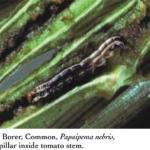Stalk Borer, Common
Papaipema nebris
Life Cycle:
The eggs of this pest overwinter on grassy weeds. Upon hatching in the spring, the borers feed on grasses. When the larvae become too large to feed within the grass, they migrate into fields, attacking border rows.
Cultural Controls & Prevention:
Eliminate grassy weeds in August by mowing or use of herbicides.
Chemical Control & Pesticides:
- Scout for injury soon after the corn emerges in the spring and treat infested plants as needed.
- Apply insecticides to outer rows at the first sign of damage by this pest.
- Treat small larvae before they bore into stalks.
For current information on production methods (including varieties, spacing, seeding, and fertility), weed, disease, and insect management, please visit the New England Vegetable Management Guide website.
Crops that are affected by this insect:
The Center for Agriculture, Food and the Environment and UMass Extension are equal opportunity providers and employers, United States Department of Agriculture cooperating. Contact your local Extension office for information on disability accommodations. Contact the State Center Director’s Office if you have concerns related to discrimination, 413-545-4800 or see ag.umass.edu/civil-rights-information.
